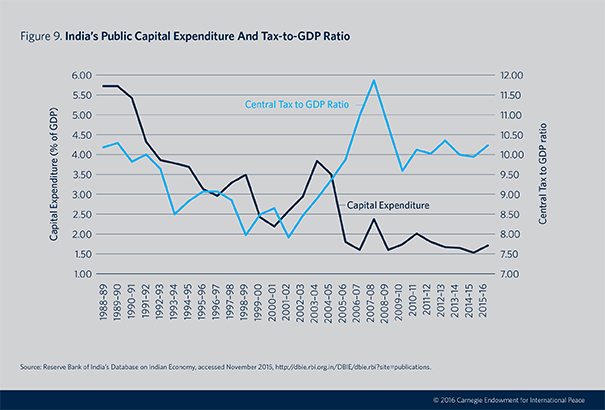By Dr. Gyan Pathak
India’s growth rate has decelerated to four years low in 2024-25, and the quarter four performance of the economy would be key to achieve the projected 6.5 per cent of GDP growth rate. More serious concern lies ahead. Even International Monetary Fund (IMF) sees India’s growth rate to remain stagnate at 6.5 per cent yearly until 2030. World Bank has said that to become a developed country by 2047, India will need an annual growth rate of 7.8 per cent. In the backdrop of such projections, India needs not only to work very hard but also a paradigm shift in its developmental policies.
The latest advance estimate of the National Statistics Office shows that country’s GDP picked pace and grew by 6.2 per cent in October-December 2024 compared to only 5.6 per cent in July September 2024. For the full financial year 2024-25, the GDP growth rate, as per the second advance estimates was seen marginally higher at 6.5 per cent as against 6.4 per cent as per the first advance estimates released in January 2025. Nevertheless, the growth will still be four years low. However, the key for achieving even 6.5 per cent growth rate will depend on the performance during January-March 2025. To achieve 6.5 per cent of growth rate in the current financial year, India will need a growth rate of 7.6 per cent in the last quarter.
It should be noted that India has revised its GDP growth rate for the year 2023-24 upward to 9.2 per cent from the earlier estimate of only 8.2 per cent. It was thus the second highest growth rate of India in the last 12 years. In 2021-22 India’s growth rate was 9.7 per cent which was from a very low base of a negative growth of (-)7.3 per cent.
The latest World Bank report released last week said that India will need to expand at an average annual rate of 7.8 per cent in real terms to realise its goal of emerging as a developed country by 2047, but to happen this all growth engines, backed by a sustained reforms push, must perform more optimally. It says that departure from business as usual approach will now be required to emerge as a high-income country. It has projected a 6.7 per cent growth rate for India for the next two years through until 2026-27.
The recent consultation pager released by the IMF has though commended India’s growth rate and said that the real GDP of the country is expected to grow at 6.5 per cent in 2024-25 and 2025-26, it has also included the downside risks too.
IMF says, “Risks to the economic outlook are tilted to the downside. Deepening geoeconomic fragmentation could affect external demand, while deepening regional conflicts could result in oil price volatility, weighing on India’s fiscal position. Domestically, the recovery in private consumption and investment may be weaker than expected if real incomes do not recover sufficiently. Weather shocks could adversely impact agricultural output, lifting food prices and weighing on the recovery in rural consumption.”
On the upside, deeper implementation of structural reforms could boost private investment and employment, raising potential growth, it says, adding India’s financial sector health, strengthened corporate balance sheets, and strong foundation in digital public infrastructure underscore India’s potential for sustained medium-term growth and continued social welfare gains.
Executive Directors have stressed that in the face of headwinds from geoeconomic fragmentation and slower domestic demand, continued appropriate policies remain essential to maintain macroeconomic stability. India’s strong economic performance provides an opportunity to advance critical and challenging structural reforms to realize India’s ambition of becoming an advanced economy by 2047.
IMF’s Macroeconomic Framework for India for 2020-21 to 2029-30, shows India’s growth rate projections. The growth rate had been decelerating from 9.7 per cent in 2021-22. It decelerated to 7 per cent in 2022-23, and 8.2 per cent in 2023-24, which Government of India had revised it recently to 9.2 per cent. Then there is a sharp decline to projected growth rate of only 6.5 per cent for 2024-25. IMF’s projection of India’s growth remains the same until 2029-30.
IMF sees saving and investment as percentage of GDP to deteriorate over the year. The projected gross savings has been estimated at 32.7 per cent for the current financial year, which is likely to decline to 30.5 per cent. Gross investment would also decline from 33.6 per cent to 32.6 per cent during this period.
As for growth rate of merchandise export, the paper sees sharp rise from 0.4 per cent in 2024-25 to 4 per cent by 2029-30. However, it also sees sharp rise in merchandise imports from 6.2 per cent to 7.2 per cent during this period.
As for India’s GDP is concerned, IMF has estimated it to be USD 3,843 billion in 2024-25. The paper has projected it to increase to USD 6,243 billon by 2029-30. It should be recalled that Modi government had claimed in 2018 that India would be $5 trillion economy by 2025. It later claimed that the government would make India a $10 trillion economy by 2030. However, India seems not on track to achieve this, it has miles to go. (IPA Service)


 Indo-US Commerce Deal May Help India Escape From Chinese Trade Trap
Indo-US Commerce Deal May Help India Escape From Chinese Trade Trap 